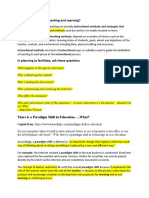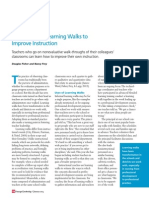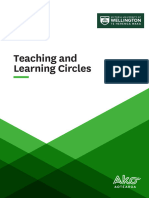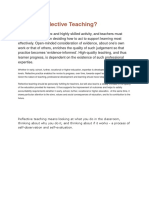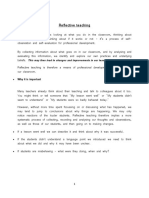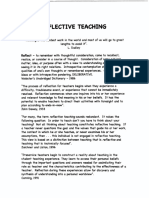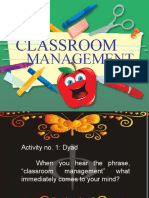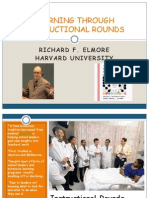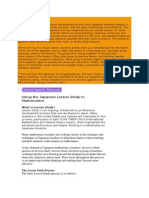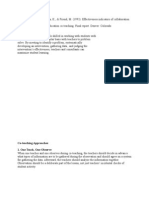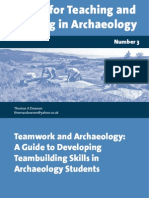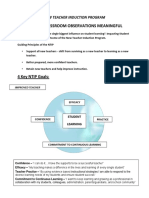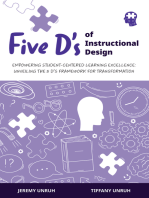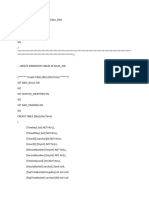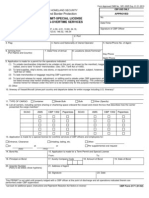Brengard ND16
Brengard ND16
Uploaded by
CHAI YEW LEE MoeCopyright:
Available Formats
Brengard ND16
Brengard ND16
Uploaded by
CHAI YEW LEE MoeOriginal Title
Copyright
Available Formats
Share this document
Did you find this document useful?
Is this content inappropriate?
Copyright:
Available Formats
Brengard ND16
Brengard ND16
Uploaded by
CHAI YEW LEE MoeCopyright:
Available Formats
Instructional
Rounds:
A Handbook for Principals
Practical steps to illuminate
the best teaching techniques,
strategies, and practices.
By Aaron Brengard
8 Principal ■ November/December 2016 THINKSTOCK; MOODBOARD; SHIRONOSOV; MONKEYBUSINESS IMAGES; LITTLEHENRABI
FdPRIN_111216_08-11_InstructionalRounds.indd 8 10/14/16 1:14 PM
A
s principal and instructional leader, teacher teams. Alternatively, schools can
I observe classrooms daily. About use shared collaboration time to conduct
three years ago, I realized that instructional rounds.
though my staff members shared After each classroom observation, teachers
ideas with one another in meetings or in the huddle up outside the classroom and take
lunchroom, they didn’t see what I saw on my turns sharing observations. For our rounds,
rounds: firsthand observations, new ideas, and we give each person a specific role tied into
best practices. That changed when we came the instructional core, taking notes on either
upon the idea of staff instructional rounds. the teacher, the students, or the content. This
During instructional rounds, groups of creates some overlap in the debrief conversation
educators move from class to class observing that helps us understand the interconnections
one another. Instructional rounds have become between the three parts of the core. For example,
the way teacher teams can see the work being one observer may note a teacher saying, “Turn
done in other classrooms, develop a shared to a partner and answer this question.” Another
understanding of high-quality instruction, and observer may add, “18 of the 24 students were
reflect on their own practice. talking with partners.”
The instructional core—the relationship The final step was to establish norms
between the teacher, the student, and the to create a level of trust among
content—is the perfect lens for instructional staff. A teacher opening his or
rounds. Anything of value in classroom her classroom to colleagues
instruction is connected by the content and what can feel vulnerable. We
the teacher and students are saying or doing. needed to keep in mind that
Teachers may have the best intentions or a we would be guests in each
curriculum may be perfectly aligned to standards, other’s classrooms and we
but what matters most is what students actually were there to learn, not
do. Instructional rounds can illuminate that. pass judgment. In fact, we
specifically chose to never
Craft the Plan, Create Norms include feedback for the
To get started, my staff and I began by reading teacher being observed in
Instructional Rounds in Education: A Network the process. The point was
Approach to Improving Teaching and Learning by to see instruction that would
Elizabeth A. City, Richard F. Elmore, Sarah E. inspire dialogue, reflection,
Fiarman, and Lee Teitel. At a staff meeting, and personal growth. Here are
we discussed rounds and established them as our norms:
a way for teachers to study their practice—not
as an evaluation tool. We explored how our ■ Focus on the instructional core—the
observations and discussions with colleagues relationship between teachers, students,
would ultimately help each individual think about and content.
his or her own classroom. ■ Honor the process and value each other’s time.
Next, we established a typical rounds cycle with ■ Seek evidence and challenge assumptions.
grade-level teams visiting three to five classrooms ■ Stay focused on mission, purpose, growth,
in other grades, making observations, and and improvement.
holding an in-depth discussion of trends and ■ Assume good intent.
next steps. While mixed-grade-level teams is
an option, we put an emphasis on the shared Making the Rounds
experience and opportunity to have deep Here’s how instructional rounds work in
discussions with grade-level peers. execution, from the pre-planning to the
In the cycle, teacher teams enter a room post-rounds action plan.
together and take low-inference notes for 10–15 Establish a problem of practice. Before
minutes. Low-inference notes are observations heading into classrooms, teachers meet and
with concrete data, and without value judgments agree upon a problem of practice. This can
or recommendations. range from trying to determine how to hold
Getting teachers out of the classroom small group instruction during math to looking
can be a logistical issue. Typically, we used for ideas to increase student engagement
teams of substitute teachers to release the during a literacy block.
www.naesp.org Principal ■ November/December 2016 9
FdPRIN_111216_08-11_InstructionalRounds.indd 9 10/21/16 10:36 AM
”As a shared experience, it was beneficial when
looking to implement one of the practices we
saw in our own classrooms. Having colleagues
open their classroom doors in order for others
to get better and hone their practice is such
a personal way to share ideas.“
Rachel Trowbridge, 1st grade teacher
Problems of practice are:
■ Directly related to student learning;
■ Focused on the instructional core;
REFLECT ■ Directly observable and actionable; and
ON THIS ■ High leverage—they make a significant
Instructional rounds
are a classroom difference for student learning.
strategy focused
around a problem
Set the schedule. Consider how to maximize As teachers enter the room, they each take
of practice, in order
to learn and extend the time when teachers observe rooms. For notes on what they see or hear. They are
practice. They are instance, don’t observe a classroom looking for encouraged to ask students questions. This
not an evaluation
a mathematic problem of practice during that helps clarify misunderstandings and allows
tool or checklist used
to “fix” teachers. classroom’s reading time. Also, avoid surprising for the observer to understand the context
a teacher by having three to five teachers or processes that were established prior.
walking in her classroom unannounced. All After the specified 10 to 15 minutes, observers
the planning and scheduling needs to be done gather outside the classroom. This is done after
prior to the day of the instructional rounds. each classroom observation. Each person takes
Here is a typical schedule: turns sharing one low-inference observation
data point until everyone has shared their ideas.
■ 8-8:30 a.m.: Set context, expectations, and focus The process is then repeated after the next
for the day. Determine visit order. observation. Typically, team members change
■ 8:30-10 a.m.: Visit classrooms. Plan for observation lenses each time. By the end of the
approximately 10 minutes inside each day’s rounds, each participant should have used
classroom and 5 minutes to debrief outside. each of the three lenses of the instructional core
■ 10-10:45 a.m.: Discussion to analyze trends. once or twice.
■ 10:45-11:30 a.m.: Create theory of action and Debrief. After a series of three to five classroom
establish next steps. visits, it is time to discuss trends and identify
promising practices. With the help of a facilitator
Conduct the rounds. With clipboards in (either the principal or a team-designated staff
hand, teachers divide among themselves the member) the team debriefs about some of the
observation lens: teacher, student, or content. trends of practice that were observed across all of
Before entering the room, it’s important the classroom visits. Our favorite way is to chart
to establish a timekeeper and some kind of responses on poster paper. These are the four
non-verbal signal that it’s time to leave. steps to debrief.
10 Principal ■ November/December 2016 THINKSTOCK; MONKEYBUSINESS IMAGES; RAWPIXEL LTD
FdPRIN_111216_08-11_InstructionalRounds.indd 10 10/14/16 1:14 PM
”I see rounds as a coaching clinic where you go in to
learn from other practitioners in their field of expertise
in real time. You learn to evaluate what works and what
doesn’t for your own personal practice.“
Sergio Hernandez, 4th, 5th, 6th grade teacher
Step 1: Describe. What do you see? Share Tip: Connect the theory
evidence of each of the parts of the instruction of action to the problem of
core in each classroom. practice established prior. Have
Tip: The best way to craft a trend is to make teachers think about how the
the description specific enough to picture the claims may address that problem.
practice or strategy, but generic enough to not
be able to identify the classroom where it was Step 4: Map the next level. How
observed. do we move instruction to the next level?
Make recommendations and set action items.
Step 2: Analyze. Identify trends across the With a theory of action, it’s time to break
instructional core. This is a chance to look for down the implementation into smaller,
similarities across the set of observational data. manageable steps. This includes deadlines,
Tip: When looking for promising practices, who is in charge, and what data will be
look for trends that will inspire the group. It’s collected to determine success.
not important to identify every trend, especially Rounds have brought a new energy to our
when they are elements already established by campus. Instead of me, the principal, being the
the team or possible negative practices. only one seeing amazing practices going on
each day, every teacher has spent a significant
Step 3: Predict. Use the evidence to make time analyzing what teaching looks like in other
claims. This step holds the real power of rounds. classrooms. While it definitely took training,
After seeing classroom experience firsthand, practice, and time to implement, we now have
teacher teams need to make some claims in a well-established instructional improvement
order to develop a theory of action. From the practice in place. Teachers participate in at
trends, identify specific practices. Then, craft least three instructional rounds cycles per year.
those practices into a theory of action using While I facilitated the trends debrief for each
“if-then” statements: If (this practice/strategy is of the teams the first time, we now have teacher
executed), then (this observable behavior will teams identify a peer to lead the facilitation.
occur), and we know because (of this outcome.) Rounds have not only expanded our teaching
Here’s an example: If we embed small group capacity, but are improving our leadership
literacy instructions into projects, then students capacity, too.
will become better readers, and we know this
because of increased fluency, accuracy, and Aaron Brengard is principal of Katherine Smith School
comprehension assessment data. in San Jose, California.
www.naesp.org Principal ■ November/December 2016 11
FdPRIN_111216_08-11_InstructionalRounds.indd 11 10/14/16 1:15 PM
You might also like
- Instructional Rounds in EducationDocument5 pagesInstructional Rounds in Educationapi-253910089No ratings yet
- Reflective PracticeDocument5 pagesReflective PracticeROYER ELIECER CHAVES CUARANNo ratings yet
- Participate in Collegial Discussions That Use Teacher and Learner Feedback To Enrich TeachingDocument16 pagesParticipate in Collegial Discussions That Use Teacher and Learner Feedback To Enrich TeachingJan Marlon Gorit100% (2)
- Sebu8554 03Document335 pagesSebu8554 03YO YO67% (3)
- Service Training 2005Document76 pagesService Training 2005Heidi Cuevas Venegas100% (1)
- Fs 1 Episode 6.editedDocument3 pagesFs 1 Episode 6.editedMike OptimalesNo ratings yet
- NSGR Study GuideDocument16 pagesNSGR Study GuideMariana Panypani ContrerasNo ratings yet
- What Teaching Styles Do You KnowDocument6 pagesWhat Teaching Styles Do You KnowNastea OstafNo ratings yet
- What Is Principles of Teaching and Learning?Document9 pagesWhat Is Principles of Teaching and Learning?Ephraim PryceNo ratings yet
- Exploring For Action, Acting For Change Stories of Exploratory Action Research in Nepal 2 PDFDocument70 pagesExploring For Action, Acting For Change Stories of Exploratory Action Research in Nepal 2 PDFValentina PruteanuNo ratings yet
- PL Jan14 InstructldrDocument4 pagesPL Jan14 Instructldrapi-291300079No ratings yet
- Classroom Observation in Teaching PracticeDocument16 pagesClassroom Observation in Teaching PracticeUmmama BhuttaNo ratings yet
- Teaching and Learning Circles Resource PackDocument16 pagesTeaching and Learning Circles Resource Packmohammad.shabytaNo ratings yet
- Reflective LogsDocument6 pagesReflective LogsZil-E- Zahra - 41902/TCHR/BATDNo ratings yet
- Ir RosemeadowDocument15 pagesIr Rosemeadowapi-253910089No ratings yet
- ch13 Lesson PlanDocument5 pagesch13 Lesson Planapi-602496947No ratings yet
- Help at Hand Developing As A TeacherDocument1 pageHelp at Hand Developing As A TeacherayeayemuNo ratings yet
- Activity 1 ReflectionDocument1 pageActivity 1 ReflectionMonica BautistaNo ratings yet
- Cooperative Language Learning RomeroDocument15 pagesCooperative Language Learning RomeroShiela mae RomeroNo ratings yet
- Learning Cultures CommunitiesDocument31 pagesLearning Cultures CommunitiesEFL Classroom 2.0No ratings yet
- What Is Reflective TeachingDocument11 pagesWhat Is Reflective Teachingjessa100% (1)
- PD Whatislessonstudy 2004 PDFDocument5 pagesPD Whatislessonstudy 2004 PDFItalo PeñarrietaNo ratings yet
- Metode Lesson StudyDocument9 pagesMetode Lesson StudyNova Astriani SpjNo ratings yet
- Collaborative LearningDocument4 pagesCollaborative LearningZine EdebNo ratings yet
- Reflective TeachingDocument6 pagesReflective TeachingA A SalmanNo ratings yet
- Reflective Teaching: Reflect - To Remember With Thoughtful Consideration, Come To RecollectDocument14 pagesReflective Teaching: Reflect - To Remember With Thoughtful Consideration, Come To Recollectወልደ መስቀል ፍቅሩNo ratings yet
- Reflective Practices CourseDocument13 pagesReflective Practices CourseFaryal IlyasNo ratings yet
- Williams A Developmental View of Classroom Observation (1989)Document7 pagesWilliams A Developmental View of Classroom Observation (1989)BritishCouncilAlgeria100% (1)
- Disciplina - Prática Pedagógica GeralDocument10 pagesDisciplina - Prática Pedagógica GeralJoao AlfandegaNo ratings yet
- SM1) V Kavitha (9920115034)Document14 pagesSM1) V Kavitha (9920115034)pavithra sNo ratings yet
- Chapter 1 - The Effective TeacherDocument38 pagesChapter 1 - The Effective TeacherAlpaslan TokerNo ratings yet
- A3 CLC Collaborative Learning CommunitiesDocument15 pagesA3 CLC Collaborative Learning Communitiesapi-596650726No ratings yet
- Teaching MethodsDocument5 pagesTeaching Methodsmitchbitch69No ratings yet
- Classroom Management 3Document57 pagesClassroom Management 3Regulus TabanaoNo ratings yet
- Palawan State University Roxas-CampusDocument33 pagesPalawan State University Roxas-CampusquejanoeveNo ratings yet
- Ir Training PPDocument16 pagesIr Training PPapi-253910089No ratings yet
- 7.09.23 Building Effective Classroom ManagementDocument29 pages7.09.23 Building Effective Classroom Managementnino.gujabidzeNo ratings yet
- What Is Lesson StudyDocument5 pagesWhat Is Lesson StudyMangalam IlangkovanNo ratings yet
- Clasroom ManagementDocument43 pagesClasroom ManagementJessaMae Albaracin100% (1)
- Advanced Principles and Methods of TeachingDocument4 pagesAdvanced Principles and Methods of TeachingJerric AbreraNo ratings yet
- Great Schools Partnership (2014) - Classroom Management.Document3 pagesGreat Schools Partnership (2014) - Classroom Management.Мария РыжковаNo ratings yet
- Unit 5Document3 pagesUnit 5Princess MendozaNo ratings yet
- Interactive Assessments: Self-AssessmentDocument8 pagesInteractive Assessments: Self-AssessmentIoana ButiuNo ratings yet
- Lesson Plan CompilationDocument8 pagesLesson Plan CompilationEljemay C. Abellanosa100% (1)
- Co-Teaching Approaches 1. One Teach, One ObserveDocument6 pagesCo-Teaching Approaches 1. One Teach, One Observesand2699No ratings yet
- Teamwork and Archaeology: Developing Teambuilding Skills in Archaeology StudentsDocument8 pagesTeamwork and Archaeology: Developing Teambuilding Skills in Archaeology StudentsDavid Connolly100% (2)
- Teaching Fellow TeachersDocument5 pagesTeaching Fellow Teachersapi-384543912No ratings yet
- Topic 3 Classroom Management and OrganizationDocument15 pagesTopic 3 Classroom Management and Organizationgmujjan1998No ratings yet
- Thirsting - For - God - Gary Thomas - 151117125737Document44 pagesThirsting - For - God - Gary Thomas - 151117125737Salvy RichardsNo ratings yet
- Unlocking Student EngagementDocument31 pagesUnlocking Student EngagementpamungkasrizalajiNo ratings yet
- Sarah Beck Martin - Learning Environment PlanDocument6 pagesSarah Beck Martin - Learning Environment Planapi-524845185No ratings yet
- Empowering Teachers Through Professional DevelopmentDocument10 pagesEmpowering Teachers Through Professional DevelopmentRicardo Cezar100% (1)
- ReflectionDocument7 pagesReflectionAriane Grace LopezNo ratings yet
- Elec 301, Unit 2 - Lesson 4Document11 pagesElec 301, Unit 2 - Lesson 4Justine OboNo ratings yet
- Collaborative LearningDocument6 pagesCollaborative LearningMANISHA DASNo ratings yet
- Ntip - Complete Booklet Final PDFDocument11 pagesNtip - Complete Booklet Final PDFJessa Lou CaguladaNo ratings yet
- CHAPTER-7.-3rd ReporterDocument3 pagesCHAPTER-7.-3rd ReporterFatima Naima SampianoNo ratings yet
- FS1 - Episode 5 - Delos SantosDocument10 pagesFS1 - Episode 5 - Delos SantosLovely Delos Santos II100% (1)
- Classroom Management Plan 1Document23 pagesClassroom Management Plan 1api-541038877No ratings yet
- Ep 5-fs1Document8 pagesEp 5-fs1Jeny MontillaNo ratings yet
- Five D’s of Instructional Design: Empowering Student-Centered Learning Excellence: Unveiling the 5 D's Framework for TransformationFrom EverandFive D’s of Instructional Design: Empowering Student-Centered Learning Excellence: Unveiling the 5 D's Framework for TransformationNo ratings yet
- Teach Like Nobody's Watching: The essential guide to effective and efficient teachingFrom EverandTeach Like Nobody's Watching: The essential guide to effective and efficient teachingNo ratings yet
- BTS4175SGA: Smart High-Side Power SwitchDocument26 pagesBTS4175SGA: Smart High-Side Power SwitchDanny Alexander Bodegas pinedaNo ratings yet
- Ufgs 33 52 43.13Document39 pagesUfgs 33 52 43.13Ramesh GanapathyNo ratings yet
- GB - Fire Protective Spray Materials - 24062011Document24 pagesGB - Fire Protective Spray Materials - 24062011Wahed Mn Elnas100% (1)
- SRS PharmacyDocument49 pagesSRS PharmacyM.Basit Rahim67% (3)
- DLP 2 (Ashley Abad)Document2 pagesDLP 2 (Ashley Abad)AshleyNo ratings yet
- Demo DWDocument85 pagesDemo DWnguyentranminhnhatkdNo ratings yet
- 5.3 Social Impacts of The Industrial RevolutionDocument36 pages5.3 Social Impacts of The Industrial RevolutionMissDang100% (2)
- AHP Balubaid, Rami Alamoudi 2015Document9 pagesAHP Balubaid, Rami Alamoudi 2015ChristinaTriAstutiPauNo ratings yet
- Name: DateDocument2 pagesName: DateThaleia MiNo ratings yet
- Android-Terminal-Emulator Wiki GitHubDocument8 pagesAndroid-Terminal-Emulator Wiki GitHubanoopkumar.mNo ratings yet
- 9 Mobile Laptop Computer Seller SampleDocument143 pages9 Mobile Laptop Computer Seller SamplesrinivasanNo ratings yet
- Boiler Tube LeakagesDocument33 pagesBoiler Tube LeakagesVIBHAV0% (1)
- ID Pola Pemakaian Kontrasepsi Dan PemanfaatDocument15 pagesID Pola Pemakaian Kontrasepsi Dan PemanfaatRosdianaNo ratings yet
- Module09 TreeBasedMethodsDocument36 pagesModule09 TreeBasedMethodsriya pandeyNo ratings yet
- U.S. Customs Form: CBP Form 3171 - Application-Permit-Special License Unlading-Lading-Overtime ServicesDocument2 pagesU.S. Customs Form: CBP Form 3171 - Application-Permit-Special License Unlading-Lading-Overtime ServicesCustoms Forms0% (1)
- Cost Accounting Worksheet Chap 3Document5 pagesCost Accounting Worksheet Chap 3Muhammad UsmanNo ratings yet
- AMMAR AKL Electric ResumeDocument4 pagesAMMAR AKL Electric ResumeENG AMMARNo ratings yet
- Programmers GuideDocument76 pagesProgrammers GuideLy TheDanNo ratings yet
- SAA-C03 Exam DumpsDocument7 pagesSAA-C03 Exam DumpsprocevisterNo ratings yet
- Virtual Showrooms in The MetaverseDocument11 pagesVirtual Showrooms in The MetaverselahirukeshavaNo ratings yet
- AerodynamicsDocument221 pagesAerodynamicskyoobumNo ratings yet
- ChexSystems Sample Disclosure ReportDocument8 pagesChexSystems Sample Disclosure Reportthirsty4knowledgexxxNo ratings yet
- Mathematics Paper 2 Q CEKENAS Mocks 2023Document21 pagesMathematics Paper 2 Q CEKENAS Mocks 2023kongoemmanuel2006No ratings yet
- Steel Fuel Supply Tube Installation InstructionsDocument8 pagesSteel Fuel Supply Tube Installation InstructionsSean DuncanNo ratings yet
- Resolution-00-2024 - AIP 2024Document1 pageResolution-00-2024 - AIP 2024barangaymuaanNo ratings yet
- Circulation PatternDocument7 pagesCirculation PatternPrince PhilipNo ratings yet
- Srs Event Management System PDF FreeDocument4 pagesSrs Event Management System PDF FreeShubham YadavNo ratings yet
- Good Agricultural Practices For Sugarcane: Thai Agricultural Standard TAS 5902-2010Document29 pagesGood Agricultural Practices For Sugarcane: Thai Agricultural Standard TAS 5902-2010Nkem Joseph-PalmerNo ratings yet








